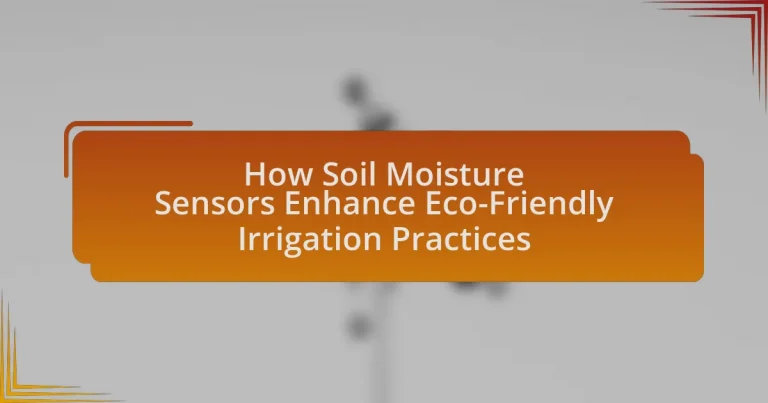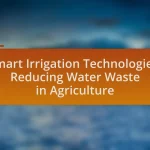Soil moisture sensors are essential devices that measure the volumetric water content in soil, playing a crucial role in optimizing irrigation practices. By providing real-time data on soil moisture levels, these sensors enable precise water application, leading to significant water savings of up to 30% and promoting sustainable agricultural methods. The article explores the various technologies used in soil moisture sensors, their environmental benefits, and their impact on crop yield and soil health. Additionally, it addresses best practices for implementation, maintenance, and troubleshooting to enhance the effectiveness of these sensors in eco-friendly irrigation systems.
What are Soil Moisture Sensors and Their Role in Irrigation?
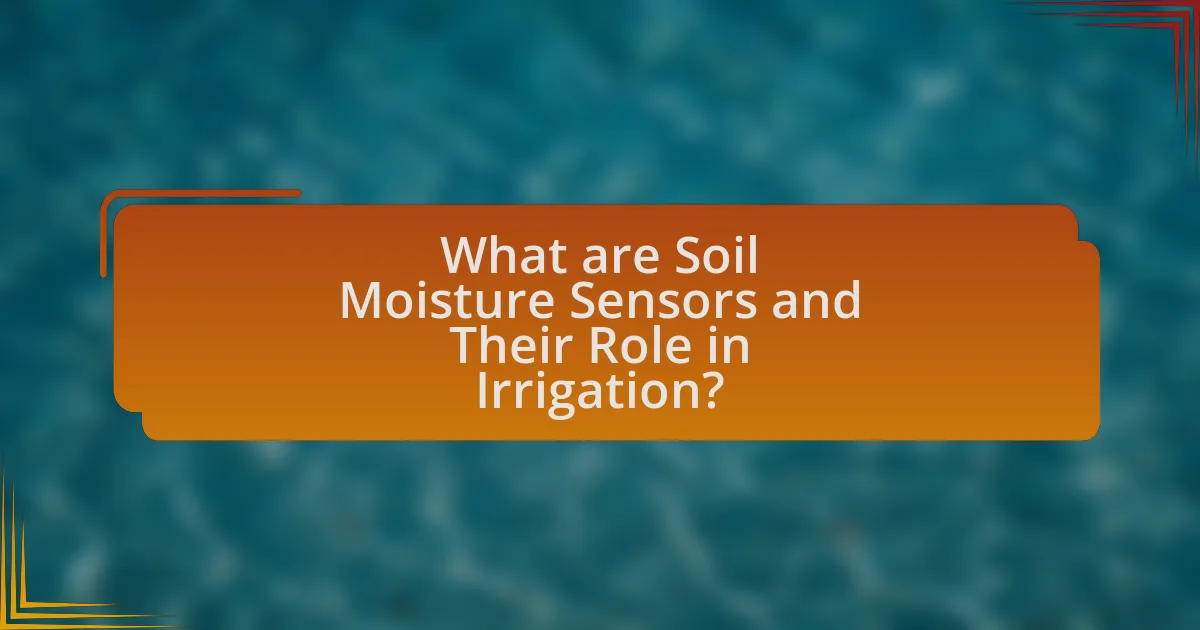
Soil moisture sensors are devices that measure the volumetric water content in soil, providing critical data for effective irrigation management. These sensors play a vital role in irrigation by enabling precise water application based on the actual moisture levels in the soil, which helps to optimize water usage and reduce waste. Research indicates that using soil moisture sensors can lead to water savings of up to 30% in agricultural practices, demonstrating their effectiveness in promoting sustainable irrigation methods.
How do Soil Moisture Sensors function?
Soil moisture sensors function by measuring the volumetric water content in the soil. These sensors typically use either capacitive or resistive methods to determine moisture levels; capacitive sensors measure changes in capacitance caused by the presence of water, while resistive sensors measure the electrical resistance between two probes, which decreases as moisture increases. The data collected is then transmitted to a monitoring system, allowing for real-time assessment of soil moisture conditions. This technology enables precise irrigation management, reducing water waste and promoting sustainable agricultural practices.
What technologies are used in Soil Moisture Sensors?
Soil moisture sensors utilize various technologies, including capacitive, resistive, and time-domain reflectometry (TDR). Capacitive sensors measure the dielectric constant of the soil, which changes with moisture content, providing accurate readings. Resistive sensors work by measuring the electrical resistance between two probes, which varies with soil moisture levels. Time-domain reflectometry employs electromagnetic waves to determine moisture content by analyzing the time it takes for the signal to reflect back from the soil. These technologies enable precise monitoring of soil moisture, essential for optimizing irrigation practices and promoting water conservation.
How do Soil Moisture Sensors measure moisture levels?
Soil moisture sensors measure moisture levels by utilizing electrical resistance or capacitance methods. In resistance-based sensors, two electrodes are inserted into the soil, and the moisture level is determined by measuring the electrical resistance between them; wetter soil conducts electricity better than dry soil, resulting in lower resistance. In capacitance-based sensors, the sensor measures the dielectric constant of the soil, which changes with moisture content; higher moisture levels increase the dielectric constant, allowing for accurate moisture readings. These methods provide real-time data that can enhance irrigation practices by ensuring water is applied only when necessary, promoting water conservation and healthier plant growth.
Why are Soil Moisture Sensors important for eco-friendly irrigation?
Soil moisture sensors are important for eco-friendly irrigation because they provide real-time data on soil moisture levels, enabling precise water application. This precision reduces water waste and ensures that plants receive the optimal amount of moisture needed for growth. Studies have shown that using soil moisture sensors can lead to water savings of up to 30% compared to traditional irrigation methods, thereby promoting sustainable water use and enhancing crop yield.
What environmental benefits do Soil Moisture Sensors provide?
Soil moisture sensors provide significant environmental benefits by optimizing water usage in agriculture. These sensors enable precise monitoring of soil moisture levels, which helps farmers apply water only when necessary, reducing water waste. According to a study published in the journal “Agricultural Water Management,” the use of soil moisture sensors can lead to a 20-50% reduction in irrigation water use, thereby conserving water resources and minimizing the impact on local water supplies. Additionally, by preventing over-irrigation, soil moisture sensors help reduce runoff and soil erosion, promoting healthier ecosystems and preserving soil quality.
How do Soil Moisture Sensors contribute to water conservation?
Soil moisture sensors contribute to water conservation by providing real-time data on soil moisture levels, enabling precise irrigation scheduling. This technology allows farmers and gardeners to apply water only when necessary, reducing overwatering and minimizing water waste. Studies have shown that using soil moisture sensors can lead to a reduction in water usage by up to 30%, demonstrating their effectiveness in promoting sustainable water management practices.
What types of Soil Moisture Sensors are available?
There are three main types of soil moisture sensors available: capacitive, resistive, and time-domain reflectometry (TDR) sensors. Capacitive sensors measure the dielectric constant of the soil, which changes with moisture content, providing accurate readings without direct contact with the soil. Resistive sensors measure the electrical resistance between two probes, which varies with soil moisture levels, although they can be less durable over time. Time-domain reflectometry sensors use electromagnetic waves to determine moisture content by measuring the time it takes for the signal to reflect back, offering high precision and reliability. These types of sensors are essential for optimizing irrigation practices and promoting water conservation in agriculture.
What are the differences between capacitive and resistive sensors?
Capacitive sensors measure changes in capacitance caused by the presence of moisture, while resistive sensors measure changes in electrical resistance due to moisture levels in the soil. Capacitive sensors typically have a longer lifespan and are less affected by soil salinity, as they do not rely on direct contact with the soil, whereas resistive sensors can corrode over time and their readings can be influenced by the ionic content of the soil. This distinction is crucial for applications in eco-friendly irrigation practices, as the choice of sensor can impact the accuracy and reliability of soil moisture measurements, ultimately affecting water conservation efforts.
How do wireless Soil Moisture Sensors enhance irrigation practices?
Wireless soil moisture sensors enhance irrigation practices by providing real-time data on soil moisture levels, allowing for precise irrigation scheduling. This technology enables farmers to apply water only when necessary, reducing water waste and promoting efficient water use. Studies have shown that implementing wireless soil moisture sensors can lead to water savings of up to 30% compared to traditional irrigation methods. Additionally, these sensors help prevent over-irrigation, which can lead to soil erosion and nutrient leaching, thereby improving soil health and crop yield.
How can Soil Moisture Sensors be integrated into irrigation systems?
Soil moisture sensors can be integrated into irrigation systems by connecting them to automated controllers that adjust water application based on real-time soil moisture data. This integration allows for precise irrigation scheduling, ensuring that water is applied only when necessary, which conserves water and promotes healthy plant growth. Studies have shown that using soil moisture sensors can reduce water usage by up to 30% compared to traditional irrigation methods, demonstrating their effectiveness in enhancing eco-friendly irrigation practices.
What challenges might arise when using Soil Moisture Sensors?
Challenges that might arise when using soil moisture sensors include calibration issues, sensor placement difficulties, and environmental interference. Calibration issues can lead to inaccurate readings, affecting irrigation decisions; studies show that improper calibration can result in a 20% error margin in moisture readings. Sensor placement difficulties arise from the need to install sensors at various soil depths to obtain representative data, which can be labor-intensive and time-consuming. Environmental interference, such as soil salinity or temperature fluctuations, can also affect sensor performance, leading to unreliable data. These challenges can hinder the effectiveness of soil moisture sensors in optimizing irrigation practices.
What are the key advantages of using Soil Moisture Sensors in irrigation?
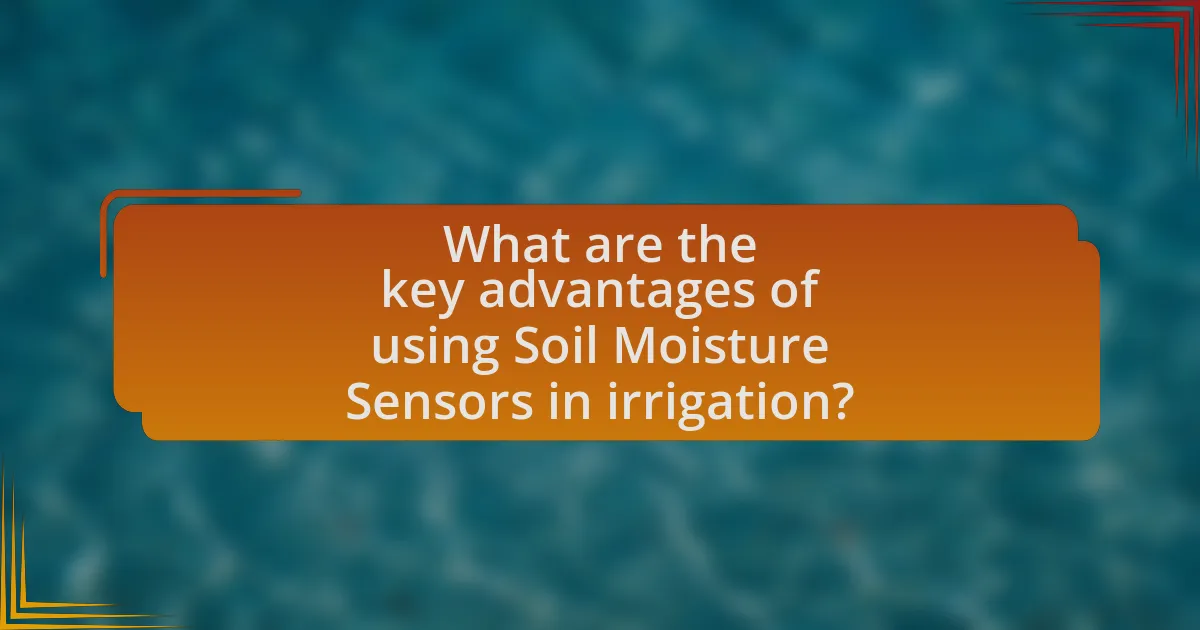
Soil moisture sensors provide precise data on soil water content, enabling efficient irrigation management. By utilizing these sensors, farmers can optimize water usage, reducing waste and ensuring crops receive adequate moisture. Studies indicate that implementing soil moisture sensors can lead to water savings of up to 30%, significantly lowering irrigation costs and promoting sustainable practices. Additionally, these sensors help prevent over-irrigation, which can lead to soil erosion and nutrient leaching, thereby enhancing soil health and crop yield.
How do Soil Moisture Sensors improve crop yield?
Soil moisture sensors improve crop yield by providing precise data on soil moisture levels, enabling farmers to optimize irrigation practices. By ensuring that crops receive the right amount of water at the right time, these sensors help prevent overwatering and underwatering, which can lead to stress and reduced yields. Research indicates that the use of soil moisture sensors can increase crop yields by up to 20% by enhancing water efficiency and promoting healthier plant growth.
What role does accurate moisture measurement play in plant health?
Accurate moisture measurement is crucial for maintaining optimal plant health, as it ensures that plants receive the right amount of water needed for growth and development. When moisture levels are accurately monitored, it helps prevent both overwatering and underwatering, which can lead to stress, disease, and reduced yield in plants. Research indicates that plants typically require specific moisture levels in the soil to thrive; for instance, many crops perform best when soil moisture is maintained between 20% to 30%. By utilizing soil moisture sensors, farmers can make informed irrigation decisions, thereby enhancing water efficiency and promoting healthier plant growth.
How can Soil Moisture Sensors help in precision agriculture?
Soil moisture sensors significantly enhance precision agriculture by providing real-time data on soil moisture levels, enabling farmers to optimize irrigation practices. This technology allows for targeted watering, reducing water waste and ensuring crops receive the appropriate amount of moisture. Studies indicate that using soil moisture sensors can lead to water savings of up to 30% while maintaining crop yield, as evidenced by research conducted by the University of California, which found that sensor-guided irrigation improved water efficiency and crop health.
What cost savings can be achieved through the use of Soil Moisture Sensors?
Soil moisture sensors can achieve significant cost savings by optimizing water usage in agricultural practices. By providing real-time data on soil moisture levels, these sensors enable farmers to irrigate only when necessary, reducing water waste and lowering water bills. Research indicates that implementing soil moisture sensors can lead to water savings of up to 30%, which translates to substantial financial savings over time. Additionally, reduced water usage can decrease energy costs associated with pumping and distributing water, further enhancing overall cost efficiency in irrigation practices.
How do Soil Moisture Sensors reduce water and energy costs?
Soil moisture sensors reduce water and energy costs by providing real-time data on soil moisture levels, allowing for precise irrigation scheduling. This technology enables farmers and gardeners to apply water only when necessary, minimizing waste and ensuring that plants receive the optimal amount of moisture. Studies have shown that using soil moisture sensors can lead to water savings of up to 30% and energy savings associated with pumping and distributing water. By optimizing irrigation practices, these sensors contribute to more sustainable water use and lower operational costs.
What is the return on investment for farmers using Soil Moisture Sensors?
Farmers using Soil Moisture Sensors can achieve a return on investment of approximately 20% to 30% through improved water management and reduced irrigation costs. This technology allows farmers to optimize irrigation schedules based on real-time soil moisture data, leading to significant water savings. For instance, a study by the University of California found that farmers who implemented soil moisture sensors reduced their water usage by up to 30%, which directly translates to lower operational costs and increased crop yields. Additionally, the sensors help prevent over-irrigation, which can lead to soil degradation and reduced crop productivity, further enhancing the overall financial benefits for farmers.
How do Soil Moisture Sensors promote sustainable farming practices?
Soil moisture sensors promote sustainable farming practices by providing real-time data on soil moisture levels, enabling precise irrigation management. This technology helps farmers apply water only when necessary, reducing water waste and conserving this vital resource. Research indicates that using soil moisture sensors can lead to a 20-50% reduction in water usage compared to traditional irrigation methods, thereby enhancing water efficiency and promoting sustainable agricultural practices.
What impact do Soil Moisture Sensors have on soil health?
Soil moisture sensors significantly improve soil health by providing precise data on moisture levels, which helps optimize irrigation practices. By ensuring that crops receive the right amount of water, these sensors prevent over-irrigation, which can lead to soil erosion, nutrient leaching, and degradation of soil structure. Research indicates that using soil moisture sensors can reduce water usage by up to 30%, thereby promoting healthier soil ecosystems and enhancing microbial activity. This data-driven approach not only conserves water but also maintains the balance of nutrients in the soil, ultimately supporting sustainable agricultural practices.
How can Soil Moisture Sensors help in reducing chemical runoff?
Soil moisture sensors help reduce chemical runoff by providing precise data on soil moisture levels, allowing for targeted irrigation and fertilization. This targeted approach minimizes excess water application, which can lead to runoff that carries chemicals into nearby water bodies. Research indicates that using soil moisture sensors can decrease water usage by up to 30%, thereby reducing the potential for chemical leaching and runoff. By ensuring that irrigation occurs only when necessary, these sensors contribute to more sustainable agricultural practices and protect water quality.
What are best practices for implementing Soil Moisture Sensors?
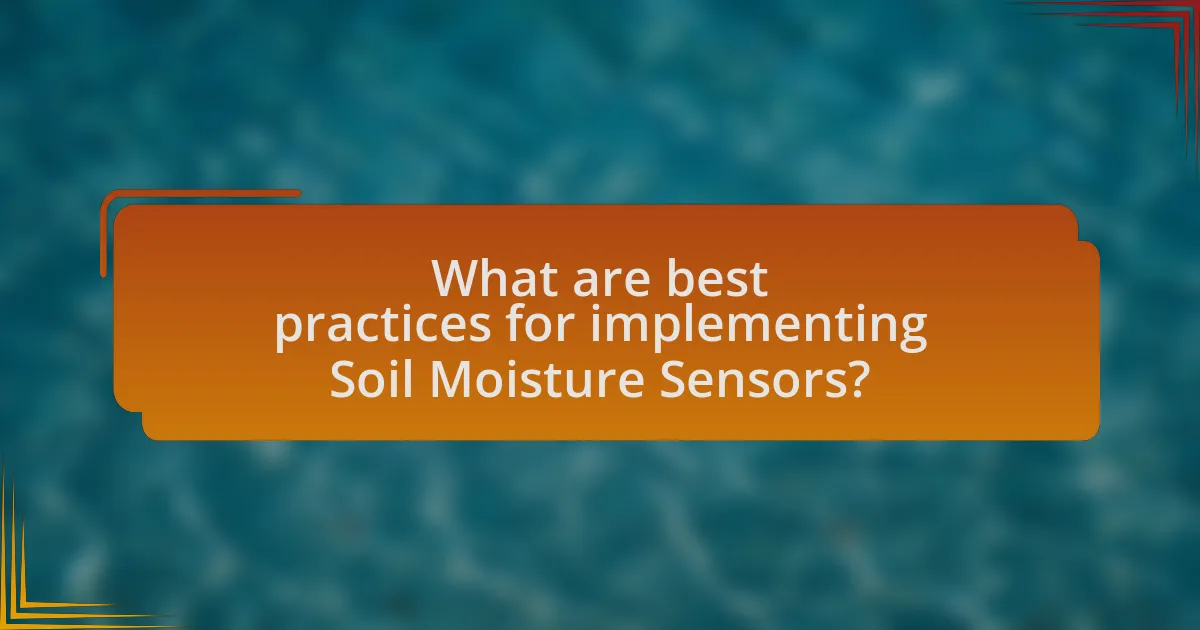
Best practices for implementing soil moisture sensors include selecting the appropriate sensor type for the specific soil and crop conditions, ensuring proper installation depth to accurately measure moisture levels, and calibrating sensors according to local soil characteristics. Additionally, integrating sensor data with irrigation management systems allows for real-time monitoring and decision-making, optimizing water usage. Regular maintenance and data analysis are crucial for maintaining sensor accuracy and effectiveness. Research indicates that using soil moisture sensors can reduce water usage by up to 30%, demonstrating their effectiveness in promoting eco-friendly irrigation practices.
How should Soil Moisture Sensors be installed for optimal performance?
Soil moisture sensors should be installed at a depth that corresponds to the root zone of the plants being monitored, typically between 6 to 12 inches deep. This depth ensures that the sensors accurately measure the moisture levels where the roots absorb water, providing reliable data for irrigation management. Additionally, sensors should be placed in areas representative of the field’s variability, avoiding locations near water sources or under tree canopies that may skew moisture readings. Proper calibration and regular maintenance of the sensors further enhance their performance, ensuring accurate and consistent data collection for effective irrigation practices.
What factors should be considered when selecting sensor locations?
When selecting sensor locations for soil moisture monitoring, factors such as soil variability, crop type, and environmental conditions must be considered. Soil variability affects moisture retention and drainage, making it crucial to place sensors in representative areas of the field to capture accurate data. The type of crop influences the moisture requirements, necessitating sensor placement that aligns with the root zones of the plants. Additionally, environmental conditions like slope, drainage patterns, and proximity to water sources impact moisture levels, thus guiding optimal sensor placement for effective irrigation management.
How can calibration improve the accuracy of Soil Moisture Sensors?
Calibration can significantly improve the accuracy of soil moisture sensors by ensuring that the sensors provide precise readings that reflect the actual moisture content in the soil. This process involves adjusting the sensor’s output to align with known moisture levels, which minimizes errors caused by environmental factors or sensor drift over time. For instance, studies have shown that properly calibrated sensors can reduce measurement errors by up to 20%, leading to more reliable data for irrigation management. Accurate readings enable farmers to optimize water usage, thereby enhancing eco-friendly irrigation practices and promoting sustainable agriculture.
What maintenance is required for Soil Moisture Sensors?
Soil moisture sensors require regular calibration, cleaning, and inspection to ensure accurate readings. Calibration is essential to maintain measurement accuracy, typically performed annually or as needed based on environmental changes. Cleaning involves removing soil and debris from the sensor surface to prevent interference with readings. Regular inspection helps identify any physical damage or malfunction, ensuring the sensors operate effectively. These maintenance practices are crucial for optimal performance and reliability in eco-friendly irrigation practices.
How often should Soil Moisture Sensors be checked and serviced?
Soil moisture sensors should be checked and serviced at least once every season. Regular seasonal checks ensure that the sensors are functioning correctly and providing accurate moisture readings, which is crucial for effective irrigation management. Additionally, any signs of malfunction or discrepancies in readings should prompt immediate inspection and servicing to maintain optimal performance.
What troubleshooting steps can be taken if sensors malfunction?
If sensors malfunction, the first troubleshooting step is to check the power supply to ensure the sensor is receiving adequate voltage. Next, inspect the sensor connections for any loose or corroded wires that may disrupt functionality. Additionally, recalibrate the sensor according to the manufacturer’s specifications to ensure accurate readings. If issues persist, test the sensor in a different location or environment to determine if external factors are affecting performance. Finally, consult the user manual for specific troubleshooting guidelines or contact technical support for further assistance. These steps are essential for maintaining the reliability of soil moisture sensors, which are crucial for optimizing eco-friendly irrigation practices.
What tips can enhance the effectiveness of Soil Moisture Sensors in irrigation?
To enhance the effectiveness of soil moisture sensors in irrigation, it is crucial to ensure proper placement of the sensors within the root zone of the plants. This placement allows for accurate readings of the moisture levels that directly affect plant health. Additionally, calibrating the sensors according to the specific soil type and moisture retention characteristics can significantly improve their accuracy. Regular maintenance, including cleaning and checking for functionality, is essential to prevent sensor malfunction and ensure reliable data collection. Utilizing data from the sensors to create a tailored irrigation schedule based on real-time moisture levels can lead to more efficient water usage, reducing waste and promoting sustainable practices. Studies have shown that optimized irrigation based on soil moisture data can reduce water usage by up to 30%, demonstrating the practical benefits of effective sensor deployment and management.
